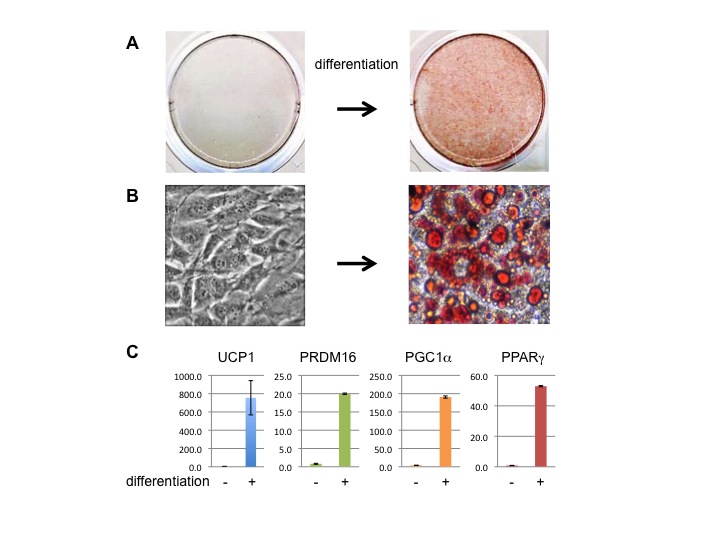Molecular mechanisms of adipocyte differentiation
Obesity has become a huge health issue in Europe and the USA. In japan, the number of obese people is increasing every year as well. Obesity is the cause of diabetes mellitus and cardiovascular diseases and could potentially increase medical costs. Therefore, development of its therapy has become an urgent issue in these countries.

Differentiation of brown preadipocytes
(A) Oil Red O staining
Left panel: Undifferentiated cells
Right panel: Differentiated cells
(B) Magnified images
(C)Induced expression of brown-specific or adipogenesis-related genes
There are two kinds of adipocyte in our bodies; white adipocytes and brown adipocytes. White adipocytes are distributed in hypodermal tissues and around the internal organs and store excess energy as fat. By contrast, brown adipocytes are present near collarbones and use fat to produce heat. Until quite recently, human brown adipocytes were believed to be present only in newborn babies but recent research revealed that brown adipocytes are also present in adult humans and has been studied extensively for prevention and treatment of obesity.
Brown adipocytes have a large number of mitochondria and UCP-1 to produce heat instead of ATP. Brown adipocytes develop from myf5-positive cells, sharing a common precursor with myocytes. PRDM16 has been shown to be a critical determinant of brown adipocyte differentiation. PRDM16 is a 140 kDa protein which has 10 zinc finger domains, and was identified as one of the genes specifically expressed in brown adipocytes. PRDM16 causes changes in gene expression pattern of myf5-positive cells and induces differentiation into brown adipocytes. However, the mechanisms by which how signals regulated PRDM16 expression remains largely unresolved. We are trying to understand the regulation of PRDM16 expression and contribute to the medical therapy of obesity.
In addition, another type of brown-like adipocytes called “beige” or brite” cells have been recently discovered. These cells show a distinct gene expression patterns and induce UCP-1 upon cold exposure and sympathetic stimulation. Beige cells are responsive to Irisin, a peptide hormone secreted from muscle cells during exercise. What Irisin does is not known at all. Recent research suggests that human brown adipose tissue consists mainly of beige cells. Studies on Irisin and its heat production mechanism should provide an important finding for obesity treatment.
We are trying to understand the differentiation mechanisms of brown or beige cells and to contribute to solve the worldwide issue of obesity.









